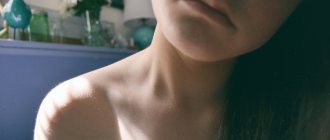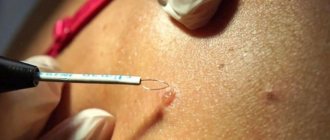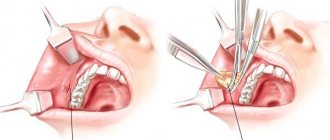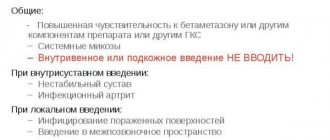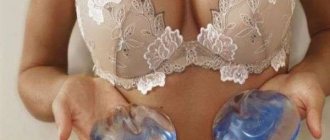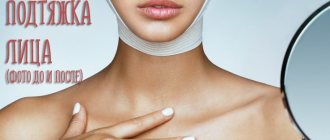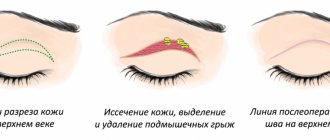A beautiful oval face without “hamster” cheeks - isn’t this what every woman dreams of? But nature has blessed few people with beautiful cheekbones and a complete absence of fat on the face. Some people turn to cosmetologists to correct their oval shape, while the more daring ones decide to undergo surgery.
Removing Bish's lumps can hardly be called a serious surgical intervention. The main thing is to get into the hands of a qualified surgeon and you will be guaranteed a beautiful oval face with sunken cheeks. However, what will happen to the face in old age, because the removal of fatty bags leads to drooping of soft tissues?! Let's look at the issue of removing Bish's lumps, as well as all sorts of emanating consequences and complications.
What are Bisha's lumps and what functions do they perform?
Bisha's lumps are two fat pads in both cheeks that help babies suckle breast milk. With age, their function is naturally lost.
Why does an adult need Bish's lumps? Some say they protect the inside of the cheeks while chewing food. However, what adult is such a clumsy chewer that he needs such protection?
Also, there is an opinion that fat packets prevent damage to the mucous membrane from the outside during facial injuries.
In fact, in adulthood, these formations are necessary for the formation of facial features and the correct oval. From the point of view of facial anatomy, sunken cheeks are pathological. Bish's lumps seem to support the tissues, preventing them from falling down.
Bisha's lumps and Robin's folds
Bichat lumps and Robin-Magiteau folds in general are a device that helps the newborn to better cover the nipple during feeding.
When sucking, the child covers the mother's nipple and the part of the areola bordering it with his lips; at the same time he lowers his lower jaw along with his tongue down. Under the influence of irritation, the nipple muscles contract, it becomes harder, thinner and somewhat lengthened.
Robin-Magiteau folds in a child contribute to a hermetic coverage of the nipple area. By moving the tongue and lower jaw in the oral cavity, the child creates a vacuum equal to 4-14 cm of water. Art. As a result of movements following one after another, the vacuum can reach 60-140 cm. Bisha's fatty lumps prevent the cheeks from pressing inward. Consequently, a closed cavity with negative pressure is obtained.
The child presses his jaws on the area of the areola, squeezes milk out of the excretory ducts of the milk passages and swallows it. One swallowing movement is preceded by several sucking movements.
Along with the milk, the baby also swallows a certain amount of air (physiological aerophagia). The entry of air into the stomach can be caused by both rapid and copious swallowing of milk and sucking on an empty breast.
Feeding in a horizontal position also contributes to aerophagia to some extent. Air swallowed by a newborn while feeding in an elevated position may rise up the esophagus into the upper part of the stomach and be released as a belch. If the air rising through the esophagus also carries away some of the milk in the stomach, then regurgitation is observed.
S. M. Becker distinguishes four phases in the act of sucking. The first phase of reception is the child’s irritation of the skin receptors of the areolar-nipple area; the second is the phase of aspiration and nipple coverage; the third is the phase of compression of the nipple, as a result of which milk is released from the mammary gland; the fourth is the phase of swallowing milk. We share the point of view of S. M. Becker on the need to highlight the reception phase in the act of breastfeeding a child. The pressure exerted by the child on the nipple is 200-300 g in a newborn and about 700-800 g in a 2-week-old child.
“Nutrition of a healthy and sick child”, B.F. Shagan
Nutrition of infants during surgical treatment of congenital pyloric stenosis (N. A. Rozanova)
N.A. Rozanova (1954) recommends that in the first 3-4 hours after surgery for congenital pyloric stenosis, give the child liquid (glucose, water) in teaspoons, then, in the absence of vomiting, expressed breast milk 10 ml after 2 hours 10 times a day ( 100 ml) with a daily addition of 10 ml for each feeding, i.e. 100 ml...
Canned foods for feeding young children
Human milk is the food that best meets the physiological needs of infants. Therefore, providing children, especially the first six months of life, with breast milk should be one of the main tasks of pediatricians. However, there are a number of circumstances when it is necessary to transfer children to partial or even full feeding with cow's milk and its mixtures. Most often, if children are healthy, transferring them to...
Nutrition of infants during surgical treatment of congenital pyloric stenosis (Ramstedt)
It is characteristic that Ramstedt, after the first operation he performed in the modification that underlies the currently used operation, believed that preserving the mucous membrane when dissecting only the muscular layer of the pylorus frees the doctor from fear for the further feeding of the child. Unfortunately, this valuable idea was forgotten. Histological examination of various sections and layers of the stomach with congenital...
Industrial method for preparing canned fruits
The industrial method of preparing canned fruits and vegetables preserves their nutritional value. The production of dry and canned products is completely mechanized, which, along with pasteurization of products and keeping all equipment clean, ensures that they are free from bacterial contamination. Powdered milk is prepared from cow's milk. The process of drying condensed milk sprayed into tiny droplets occurs at a temperature no higher than…
Nutrition of infants during surgical treatment of congenital pyloric stenosis (Mucous wound)
Our many years of experience have shown that in cases where during the operation there was no injury to the mucous membrane and other aggravating aspects (ligation of blood vessels in the stomach, difficulty in repositioning it after myotomy, etc.), especially if the operation was performed in the early stages of clinical detection diseases, children after it actively took the breast, often sucking already in the first 48...
Who is contraindicated to remove Bish's lumps?
Bisha's lumps gradually decrease with age, so girls under 25 years old are not recommended to undergo the procedure for their removal. It is quite possible that natural regression of these formations will occur and the need for surgery will no longer be necessary.
You may be denied an operation if you have serious internal diseases that either are a contraindication to the use of anesthesia or affect blood clotting.
The procedure is contraindicated in the following cases:
- severe liver pathologies, cirrhosis;
- diabetes mellitus with uncontrolled blood sugar levels;
- decompensated heart and vascular diseases;
- hemophilia, low blood clotting;
- severe obesity or, conversely, exhaustion.
Also, surgery should not be performed in cases of exacerbation of chronic diseases, colds, or the presence of rashes, in particular, herpes on the face.
Preparing for surgery
The operation to eliminate Bisha's lumps is carried out as planned, after a complete examination of the patient and identification of possible contraindications. The preparation stage for intervention usually involves:
- Taking tests (urine, blood).
- Preliminary consultation with a surgeon.
- If necessary, undergo additional consultations and examinations.
At least a week before the operation, you should give up bad habits, taking vitamins and medications that thin the blood. Directly on the day of your visit to the clinic, you must refrain from using cosmetics.
What are the consequences after removing Bisha's lumps?
The consequences after removing Bisha's lumps can be divided into inevitable and undesirable, that is, complications.
Inevitable consequences develop immediately after surgery. These include:
- swelling of the facial skin;
- bruises (when removed not through the mucous membrane);
- pain when chewing.
All this goes away within a few days as the surgical wound heals.
Undesirable consequences can be divided into:
- Early, occurring immediately or within a few days after surgery.
- Late, developing after 10 years and in old age.
How to remove Bish's lumps without surgery
Non-surgical removal of Bisha's lumps will take much longer, and the result may not be as fast. However, many refuse surgery and prefer to lose weight in their face naturally, using various diets, exercises, massages or traditional methods.
There are several ways to remove Bish's lumps at home:
- Avoiding foods that cause fat accumulation. The body , when following a diet, loses weight faster than the face, since the fat in the cheeks is denser and burns slowly, but if you follow a diet and a proper lifestyle, metabolic processes are normalized, which will lead to weight loss in the cheeks. A woman needs to give up fatty and sweet foods, drink at least 2.5 liters of water a day, and eat as many vegetables and fruits as possible.
- Self-massage of the face. When performed regularly, metabolic processes in the dermis are accelerated and the amount of fat deposits is reduced. The massage is carried out using the method of pinching, stroking and patting. It is enough to devote 15 to 20 minutes a day for this procedure.
- Gymnastics for the face. Consists of maximum inflation and deflation of the cheeks. For gymnastics, 10–15 exercises per day are enough.
- Face masks with essential oils. The use of essential oils will help make the skin tightened and elastic, and speed up blood circulation. A good effect can be obtained from olive and orange oils; St. John's wort and jojoba oils are also widely used. They can be used during massage.
In addition to home methods to remove Bisha's lumps, excellent results can also be obtained from salon procedures.
- RF lifting.
- Lymphatic drainage massage.
- Mesotherapy.
Before using any salon procedure, you need to consult a cosmetologist who can choose the most effective method to eliminate the problem.
Getting rid of Bisha's lumps is not at all difficult, the main thing is to choose the most suitable procedure, contact a qualified doctor who will perform the operation at the highest level.
Complications that may occur immediately after surgery
Before we deal with the long-term consequences, let's see what can happen during or immediately after the operation?
- An allergic reaction to the anesthetic, which is manifested by a drop in blood pressure, nausea, vomiting, and a rash on the body. To avoid this, the doctor will talk with you before the intervention about how you previously tolerated pain-relieving injections and, if necessary, do a skin test.
- Bleeding. This complication can develop during surgery if a large vessel is damaged or in the postoperative period if the wound is handled improperly. You may also experience bleeding if you have hemophilia or low blood clotting ability. Therefore, before the intervention, every competent doctor will order a blood test and ask about all concomitant diseases.
Important!
Choose experienced surgeons and carefully consider all the doctor’s recommendations! Remember that surgery does not allow for savings, so a competent doctor who uses high-quality materials and instruments and has undergone the necessary training cannot do it cheaper than everyone else!
Consequences that may appear after 10 years and in old age
In old age, the absence of fat packets leads to pronounced ptosis (drooping) of soft tissues. However, with age, oval sagging will occur in every woman, and whether the lack of fat bodies will be to blame for this is a question. By the way, for some older women, removing Bisha's lumps allows, on the contrary, to correct age-related changes.
Also, you may hear that after removing Bisha's lumps, after 10 years the skin of the cheeks becomes flabby. Some people are inclined to believe that the removal of fatty bags may be to blame, but from a medical point of view, sagging skin is caused by a reduced content of collagen and elastin, which has nothing to do with the fat cells on both sides of the cheek. In addition, Bisha's lumps increase the load on the facial muscles, which also leads to rapid aging and sagging of soft tissues.
Prevention of complications. What should you pay attention to?
In order to avoid complications during and after the operation, you should properly prepare for the intervention. To do this, the doctor prescribes a series of preoperative examinations, including:
- general blood and urine analysis;
- study of liver parameters, blood sugar, bilirubin, urea.
Among the instrumental methods, fluorography and ECG are prescribed. An examination by related specialists is required: a gynecologist and a therapist. If the patient has any chronic diseases, then others may be added to these examinations to determine the state of the body’s disturbing system.
Sometimes, after removing Bisha's lumps, the cheeks become too hollow. This happens if the fat lumps are too large. To avoid this complication, before surgery the doctor carefully examines and palpates the cheek area. And some advanced centers offer computer modeling - based on the patient’s data, to build the shape of the face that will be after the operation. If necessary, fat bags can be partially removed or moved to the cheekbone area, making the face even more similar to the desired one.
Immediately after surgery, pay attention to the following restrictions and do not ignore them:
- Smoking is prohibited for 3-5 days.
- As long as there is swelling (5-7 days), do not drink hot drinks, as this will only worsen the swelling.
- Until postoperative wounds heal, avoid eating rough food, and in the first 2-3 days it is recommended to eat broth and dairy products - this way you will eliminate mechanical damage to postoperative wounds.
- Brush your teeth carefully so as not to damage the stitches.
- For the next 2 weeks, sleep exclusively on your back with a high pillow - this measure will help avoid worsening swelling after sleep.
- Hot showers, baths, baths and saunas are prohibited for 2 weeks after surgery.
- Eliminate physical and psycho-emotional stress for the next 2 weeks, and after this time, return to the normal rhythm of life gradually, do not immediately run to the gym and do your usual activities.
It is important that the doctor correctly explains to the patient what to do and how to behave. If you still have unclear points, discuss them before the operation, because after the intervention you will be able to leave the clinic in a few hours and, perhaps, you will not have the time or desire to communicate with the doctor.
If you have found an experienced plastic surgeon, have undergone a preventive examination, are aware of all the risks, and understand how to behave after the operation; For you, the question about the consequences of
removing Bish’s lumps and complications is completely clear, then you have done everything possible to protect yourself.
As for the long-term consequences, think about whether they are so important, because in old age and without this operation the face will undergo drooping, but you want to be beautiful here and now!
July 28, 2020 by anna
